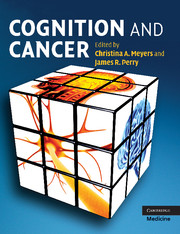Book contents
- Frontmatter
- Contents
- List of contributors
- Preface
- Section 1 Cognition and the brain: measurement, tools, and interpretation
- Section 2 Effects of cancer and cancer treatment on cognition
- 7 Biological bases of radiation injury to the brain
- 8 Cognitive dysfunction related to chemotherapy and biological response modifiers
- 9 Effect of hormones and hormonal treatment on cognition
- 10 Low-grade gliomas
- 11 High-grade gliomas
- 12 Brain metastases
- 13 Primary central nervous system lymphoma
- 14 Childhood brain tumors
- 15 Neurofibromatosis
- 16 Hematological malignancies
- 17 Paraneoplastic disorders
- 18 Symptomatic therapies and supportive care issues
- 19 Animal models and cancer-related symptoms
- Section 3 Interventions and implications for clinical trials
- Index
- Plate section
- References
14 - Childhood brain tumors
Published online by Cambridge University Press: 13 August 2009
- Frontmatter
- Contents
- List of contributors
- Preface
- Section 1 Cognition and the brain: measurement, tools, and interpretation
- Section 2 Effects of cancer and cancer treatment on cognition
- 7 Biological bases of radiation injury to the brain
- 8 Cognitive dysfunction related to chemotherapy and biological response modifiers
- 9 Effect of hormones and hormonal treatment on cognition
- 10 Low-grade gliomas
- 11 High-grade gliomas
- 12 Brain metastases
- 13 Primary central nervous system lymphoma
- 14 Childhood brain tumors
- 15 Neurofibromatosis
- 16 Hematological malignancies
- 17 Paraneoplastic disorders
- 18 Symptomatic therapies and supportive care issues
- 19 Animal models and cancer-related symptoms
- Section 3 Interventions and implications for clinical trials
- Index
- Plate section
- References
Summary
In long-term survivors of childhood and adolescent central nervous system (CNS) tumors, neuropsychological and psychosocial late effects of therapy occur in a milieu of numerous medical late complications (Anderson et al., 2001). With improvements in treatment and survival rates for these patients since the 1980s, most children and adolescents with CNS tumors currently diagnosed will become long-term survivors (Pollack, 1994). This is particularly true for children with medulloblastoma or low-grade astrocytoma. Therefore, concerns about late complications of therapy are increasingly important to survivors and their families. In addition to the late consequences of radiation therapy and chemotherapy, which are similar for all survivors of childhood cancer, the singular susceptibility of the brain and spinal cord to injury causes several late consequences unique to long-term survivors of CNS tumors.
Late complications may be due to the tumor, surgery, radiation therapy, chemotherapy, or the psychological trauma of dealing with a malignancy, and the late effects following CNS tumors include medical, psychological, neuropsychological, and psychosocial problems. Some late effects may be life threatening. In fact, long-term survivors of CNS tumors have an excess risk of mortality relative to survivors of other cancers (Mostow et al., 1991; Nicholson et al., 1994). In a large cohort study of childhood cancer survivors (Oeffinger et al., 2006), CNS tumor survivors were among the most likely to have chronic health conditions and multiple other chronic conditions; in addition, they often have functional impairments (Ness et al., 2005).
- Type
- Chapter
- Information
- Cognition and Cancer , pp. 198 - 210Publisher: Cambridge University PressPrint publication year: 2008



